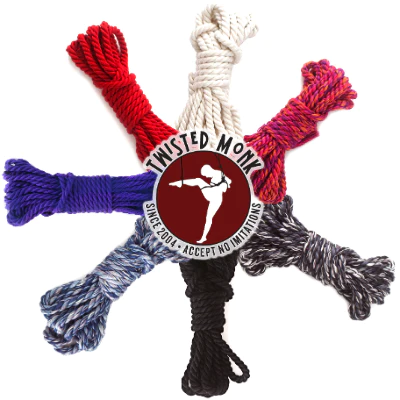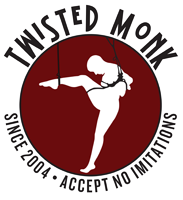The Joy of POSH
Ah, POSH, how I love thee! Let me count the ways…
I love POSH to the depth (of risk budgeting) and breadth (of increased safety margin) and height (of the absolute best all-around synthetic upline material) my soul can reach! My thoughts get a bit less poetic, but more detailed, from there.
To start with some definitions: the acronym POSH stands for Port side Out, Starboard Home. As one might imagine based on that, POSH rope is traditionally used for nautical applications (although the manufacturer knows what we’re up to—their website mentions that it is a great choice for “decorative knotwork with your friends.”) POSH is made of fine spun polyester yarns.
Getting into more general rope terms—you’ll often see references to breaking strengths. This represents the rope’s ability to endure pulling forces, and the number is the maximum amount of weight the rope can withstand before failing. POSH that’s 6mm has a breaking strength of 1,200 pounds; 6mm jute, by contrast, has a breaking strength of around 200 to 300 pounds (with a lot of variability). Keep in mind that any knots or bends further weaken the rope and decrease the breaking strength. Additionally, lifting into suspension, and especially doing drop lifts or other dynamic maneuvers, routinely applies much more force to the upline than the weight of the person in rope (PIR).
A safety margin of 10 times the weight of the person being lifted is standard for rescue, construction, and professional rigging involving lifting humans (such as circus apparatuses). This seems like a reasonable standard, or at least goal, to carry over into critical uplines for suspension bondage. Sometimes called “main support lines,” critical uplines are the ropes that keep the PIR from using the ground as a nonconsensual impact implement (to quote WhiskyTangoFoxy). Secondary lines are extra supports, such as a thigh or foot line when the PIR already has a chest and/or hip harness secured. For secondary lines, using whatever type of rope is used for harnesses is fine. For keeping the brain and spine intact, considerations are different.
Because the goals and risk profiles for harness rope and critical uplines differ, I generally use different rope for these purposes. For critical uplines, my main goal is strength; other considerations include the feel of the rope for gripping/handling and ease in creating and undoing tie-offs. For harnesses, on the other hand, main considerations include what feels good against the skin (which is entirely subjective) and suitability for specific ties and circumstances (hemp holds frictions well, while nylon is uniquely suited for water bondage, for example). For both, aesthetics are another consideration.
Why is strength a bigger consideration for uplines than for harness rope? The forces on uplines are quite different from the forces on harnesses. In every rope-break-incident report I am aware of, the upline, not the harness rope, was what broke. Harnesses generally have built-in redundancy, as you use hangers to load multiple wraps (often at least four strands, and frequently eight or more, of rope); in most cases, even if a few of the strands of rope making up the harness were to break, it wouldn’t cause catastrophic failure. Ideally, uplines would also be configured without single points of failure; however, there is generally much less redundancy, and most breaks happen during upline adjustment (often lifting). Now, this isn’t to say you can use rolled-up tissue paper to create your harnesses! Be mindful of how you’re loading (for example, attach from harness wraps instead of stems) and make reasonable choices, with an understanding of where most of your risk generally originates.
Moving into risk budgeting, we make decisions to participate in risky activities all the time—for example, every time we get into a car (and don’t get me started on motorcycles). We also take reasonable steps to mitigate risk, such as putting on our seat belts and turning on headlights when it’s dark. When it comes to activities like bondage, risk mitigation isn’t always straightforward. Some risks are intrinsic and inherent—sometimes that intrinsic risk is even part of the appeal! We’re never going to reduce risk to zero. It’s important to consider your risk budget, mitigation steps, and whether the activity is ultimately worth it to you. Ask questions like: “Are the risks I’m taking intrinsic to this? Or are they unnecessary? Are they sexy or exciting risks? How can I help offset riskier aspects by making more cautious choices in other areas?” Personally, I have a pretty conservative risk budget, and I want to spend that budget in areas that are the most enjoyable and/or unavoidable, while striving to minimize senseless risk. As such, using synthetic uplines is in my opinion an exceptionally good bang for my buck, in terms of risk budgeting. My specific kinks don’t include risking debilitating or deadly falls due to hanging from the ceiling with woven grass clippings, so personally I don’t see many reasons to not use rated rope for critical uplines. And as Topologist points out, the material of the uplines does nothing to contribute to the PIR’s experience.
Because the quality and strength of natural fiber rope varies considerably, the safety margin of using jute in particular for uplines is outside what I personally consider acceptable for myself, even at baseline. Then there are many factors that can pile up to make the odds of failure even higher—inattention to rope wear, lack of maintenance, lifting with the upline, using tie-off techniques that apply extra strain, or the PIR’s being larger-bodied. If you erode a tiny safety margin bit by bit, it doesn’t take much before your margin is entirely gone and something tragic happens. Yes, in most cases jute uplines will not break. In most cases, you won’t crash your car—does that mean you shouldn’t bother wearing a seat belt? There are ways to make using unrated uplines relatively less risky (avoiding “burning the bight,” using critical lines only for static support, carefully inspecting the rope before each use, and avoiding any dynamic lifts or movement, to name a few). Do you want to spend your mental energy fussing over those factors? Or would that mental space perhaps be better used elsewhere? Personally, I prefer to have a large, forgiving margin for error in this area, rather than playing a high-stakes game with little room for miscalculation (and significant odds of failure even if I do everything “right”).
Some final general notes about POSH and why I love it so much that I feel inspired to quote Shakespeare’s Sonnet 43: It’s hypoallergenic, so for folks with allergies to natural fibers, a full kit of POSH can be a way to get a similar look and feel. If you like using natural fibers for your harnesses, POSH can fit in reasonably well both aesthetically and tactilely with a natural fiber kit (Twisted Monk finishes POSH ends with orange whipping, because otherwise it blends in so well that it can be hard to find it in a kit of hemp). Some folks have a concern that synthetics may melt in certain bondage situations, such as with high friction or under bright stage lights; while superficial melting at points of high friction is theoretically possible in the most extreme bondage applications, this won’t immediately render unsafe a thick synthetic line with a very large safety margin, and it’s easy to avoid with good technique. Additionally, POSH has a melting temperature on the high end for typical synthetic ropes (265 degrees Celsius, or 509 degrees Fahrenheit). POSH has a good hand-feel—it’s comfortable for gripping and lifting, and holds frictions reasonably well, without being particularly prone to jamming. POSH is even machine washable/dryable. I can’t say that I shall love it better after death, but I do feel confident that my POSH helps keep me safe to tie another day!
Author Shay Tiziano is a renowned self-suspender based in San Francisco, with more than a decade of experience educating and performing around the world.
We currently offer Shay's book Tying & Flying
Find our newest POSH colors here and some older favorites here.
All of your specialty steel suspension needs are available here.
Also in News

Exotic Bamboo Rope Review by Pete Riggs of Ropeconnections.com
Pete Riggs of Ropeconnections.com recently did a very through and in depth review of our exotic bamboo ropes, including washing! Check it out, along with tons of other great rope content and tutorials!


